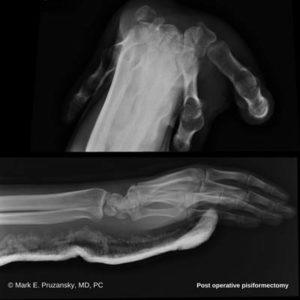Pisiform Fractures

Pisiform fracture, before and after surgery
What are Pisiform Fractures?
The pisiform is a sesamoid bone found within the flexor carpi ulnaris tendon. The pisiform is easily palpable on the volar surface of the wrist, proximal to the fifth metacarpal.
As a result of greater participation in sporting activities, injuries to the ulnar aspect of the carpus are steadily becoming more prevalent. Fractures of the pisiform are uncommon and may be associated with other carpal or distal radius injuries.
Types of Pisiform Fractures
Fractures of the carpal and metacarpals account for 6% of all fractures. Fractures of the pisiform are rare and are typically associated with other carpal or distal radial injuries.
This injury accounts for around 2% of all carpal fractures, making it a rare injury that is often missed or mistaken for another condition. Additionally, pisiform fractures are most often associated with more severe injuries of the upper extremities. They can also be difficult to see on routine radiographs of the wrist.
Characteristics and Clinical Presentation of Pisiform Fractures
This injury presents as chronic wrist pain, grip weakness, and/or restriction of wrist movements. Pisiform fractures may also be associated with tenderness in the affected area.
Most pisiform fractures are a result of falling onto an outstretched hand (FOOSH injuries). They do not often occur alone and are often associated with other injuries including the ligaments of the pisotriquetral joint.
Getting a Diagnosis for Pisiform Fractures
Early diagnosis of pisiform fractures is often difficult and sometimes missed during the first presentation. This is due to superimposition of adjacent carpal bones.
Radiographs are the most common diagnostic tool for this injury. CT scans may be required.
Treatment Options for Pisiform Fractures
Early diagnosis of a pisiform fracture is important because a misdiagnosis or delayed treatment has the possibility of resulting in a non-union or malunion of the affected region. Furthermore, untreated pisiform fractures may contribute to arthritis and other painful conditions in the area.
Conservative Treatments
Pisiform fractures are often managed by immobilization in fiberglass cast or a wrist splint. Many patients are able to regain full function of their wrist after a period of immobilization in a wrist splint.
Surgical Treatments
Nonunions and malunions are typically managed by surgical excision of the pisiform bone. internal fixation with cortical screws to secure a reduction is uncommon as differences in recovery are inconclusive.
Preventing a Pisiform Fracture
Prevention concerns the underlying activity. Balance, strength, skills, and strengthening the kinetic chain are targets.
Prognosis for Pisiform Fractures
Patients can typically look forward to a short period of immobilization for 4-6 weeks. Many patients experience a good clinical response with full return of mobility to the wrist following this period.
It is important for patients to receive treatment quickly after a pisiform fracture due to the fact that a malunion, or nonunion, may occur otherwise.
If You Believe You Have a Fracture, Contact HandSport Surgery Institute.
Please contact us as soon as possible to schedule an appointment with our talented team. People who have been hurt should be evaluated to try and prevent further injury and mobility issues.
If you have been injured, it’s important to be evaluated by a highly skilled professional. Call Drs. Mark and Jason Pruzansky at 212-249-8700 to schedule an appointment and obtain an accurate diagnosis.



